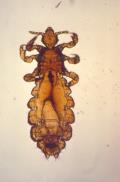07 Sep Over the Counter Lice Remedies Unlikely to Be Effective
MedicalResearch.com Interview with:
William Ryan B.V.Sc.
Ryan Mitchell Associates LLC
Westfield, NJ and
Bernard Cohen, MD
Professor Dermatology and
Ellen Koch, MD
Division of Pediatric Dermatology
Johns Hopkins Medicine, Baltimore, Maryland
MedicalResearch.com: What is the background for this study? What are the main findings?
Response: As a group we were concerned about the misinformation that continues to be promulgated on the internet and through other sites. Importantly, the group consisted of experts with specific experience in the management of head louse infestations, from pediatric dermatology, pediatrics, school nursing and head louse research fields. Even information sources that we would have expected to be credible are outdated, unreliable or both, often continuing myths about head louse infestations and how they can be controlled. We wanted to provide a balanced and informed perspective that would help physicians and parents recognize that head louse infestations do not present a serious problem, and can be well managed with an informed approach to treatment.
The main findings are that over the counder products (permethrin/pyrethrins) are unlikely to be effective, and that that there are safe and effective products that are available by prescription.
Interestingly, head lice do affect Indian and African children in their home countries, but virtually nonexistent in African Americans in North America. There has been speculation about hair grooming regimen or structure of African American hair but the cause is unknown. In a study we performed assessing resistance to over the counter pediculicide components over a decade ago in Baltimore, we were not able to find a single African American child with head lice. We were not able to recruit any patients from the Baltimore City Schools.
MedicalResearch.com: What should readers take away from your report?
Response: If parents want to have the best opportunity to quickly eliminate head louse infestations with a single treatment they should start with a prescription product. In particular, the newer products that have received FDA approval – Natroba and Sklice – were shown effective without the need for nit combing (which may be desirable for cosmetic reasons).
“No nit policies” are not supported by the School Nurses Association. If a child has been treated and no live crawlers have been identified for over a week, the child has been adequately treated, and the presence of nits does not indicate active infection. The organisms do not jump or fly so close physical contact is required for transmission. That is why the infestation is more likely to spread at home than in school particularly in older children.
MedicalResearch.com: What recommendations do you have for future research as a result of this study?
Response: Education from informed sources is the greatest priority. With the exception of lindane, the prescription products we have are safe and work well (but new proven products are always good to have to expand choice and reduce dependence on just one or two). There needs to be recognition that head lice do not typically present any form of health hazard. Stigmatization and isolation of infested children cannot be justified. Authoritative bodies that publish recommendations should base these on informed expert opinion.
Although not approved in the US, there are a number of studies assessing the use of safe oral agents for treating head lice particularly in communities where head lice are endemic.
MedicalResearch.com: Is there anything else you would like to add?
Response: Parents should accept that head louse infestations are just one of those things and are not an indication of a lack of good hygiene or of poor health. Transmission is almost always directly head-to-head. Parents should not use home remedies, and would be much better getting a prescription product right from the start, to minimize the risk that they are going to have to keep going back to get more treatments. Read the label – the prescription products are safe, especially the more recent ones.
MedicalResearch.com: Thank you for your contribution to the MedicalResearch.com community.
Citation:
Ellen Koch, John Marshall Clark, Bernard Cohen, Terri L. Meinking, William G. Ryan, Audrey Stevenson, Robert Yetman, Kyong Sup Yoon. Management of Head Louse Infestations in the United States-A Literature Review.
Pediatric Dermatology, 2016; 33 (5): 466
DOI:10.1111/pde.12982
Note: Content is Not intended as medical advice. Please consult your health care provider regarding your specific medical condition and questions.
More Medical Research Interviews on MedicalResearch.com
[wysija_form id=”5″]
Last Updated on September 7, 2016 by Marie Benz MD FAAD

